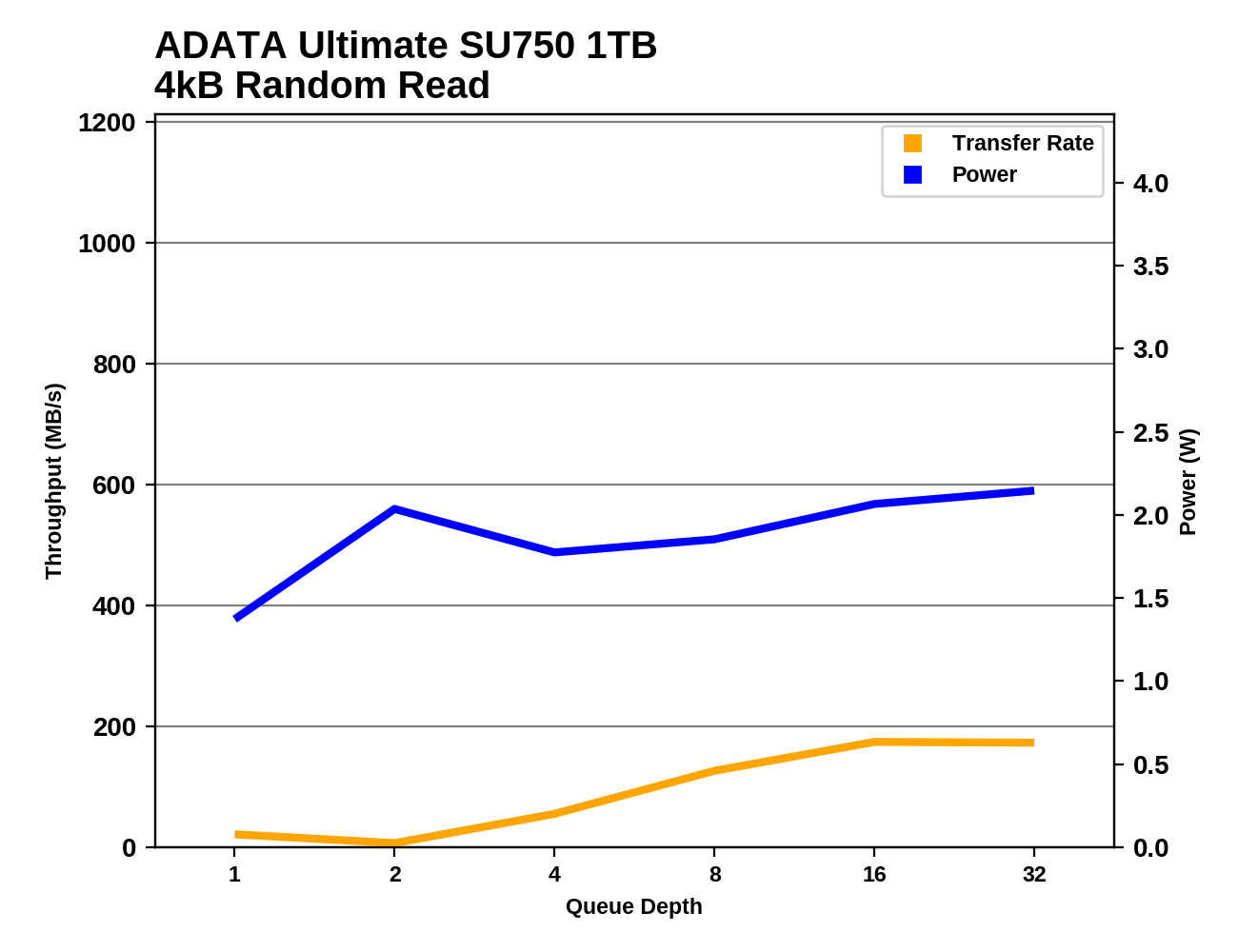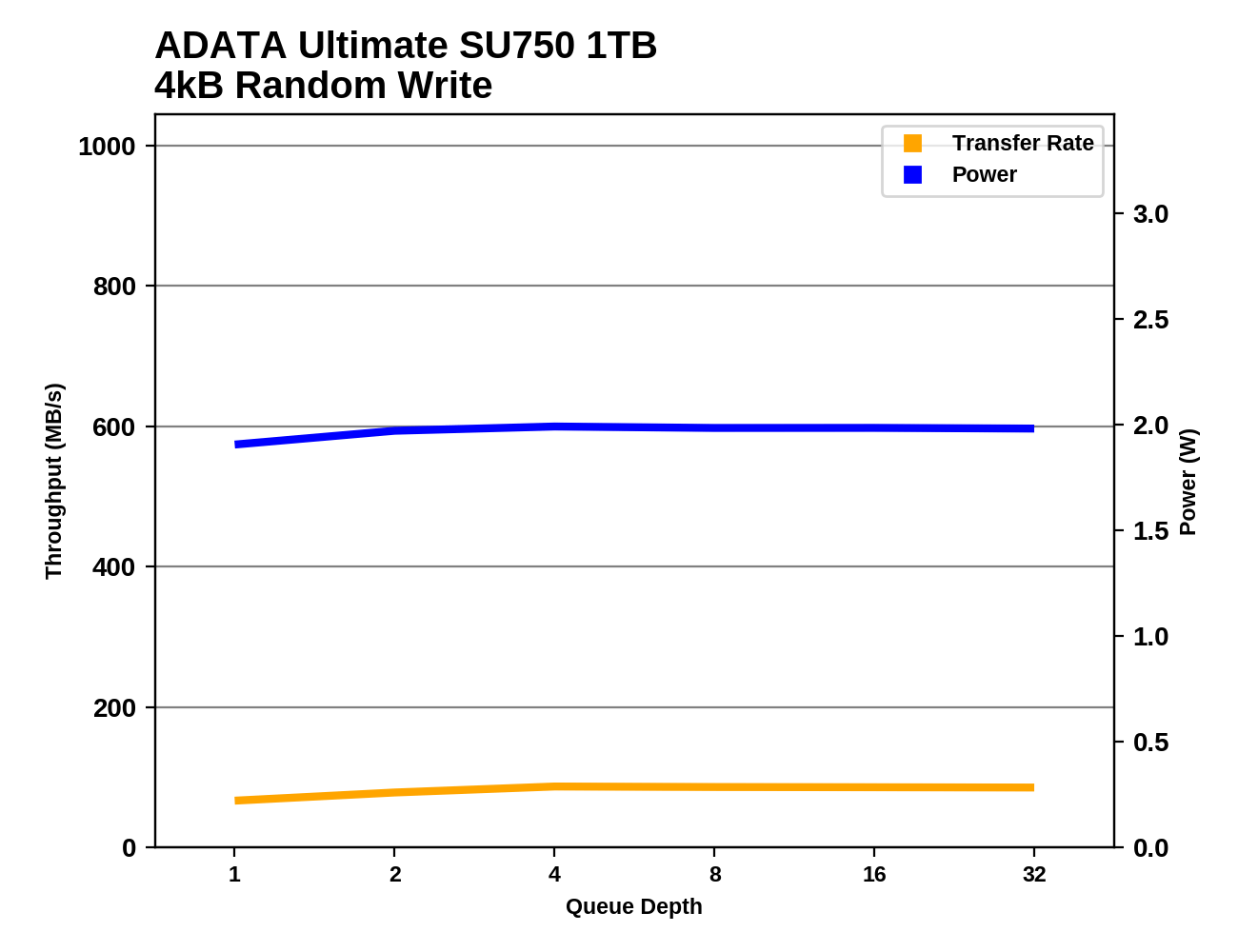The ADATA Ultimate SU750 1TB SSD Review: Realtek Does Storage, Part 1
by Billy Tallis on December 6, 2019 8:00 AM ESTRandom Read Performance
Our first test of random read performance uses very short bursts of operations issued one at a time with no queuing. The drives are given enough idle time between bursts to yield an overall duty cycle of 20%, so thermal throttling is impossible. Each burst consists of a total of 32MB of 4kB random reads, from a 16GB span of the disk. The total data read is 1GB.

The burst random read performance from the ADATA SU750 is pretty good for a DRAMless SSD and competitive with mainstream SATA drives.
Our sustained random read performance is similar to the random read test from our 2015 test suite: queue depths from 1 to 32 are tested, and the average performance and power efficiency across QD1, QD2 and QD4 are reported as the primary scores. Each queue depth is tested for one minute or 32GB of data transferred, whichever is shorter. After each queue depth is tested, the drive is given up to one minute to cool off so that the higher queue depths are unlikely to be affected by accumulated heat build-up. The individual read operations are again 4kB, and cover a 64GB span of the drive.

On the longer random read test, the SU750 falls to last place and is clearly slower than the other DRAMless SATA drive (Toshiba TR200) and the QLC-based Samsung 860 QVO.
 |
|||||||||
| Power Efficiency in MB/s/W | Average Power in W | ||||||||
The SU750 fares even worse on the power efficiency metrics, since it draws significantly more power here than any of the other SATA drives, despite being the slowest. This stands in stark contrast to the low power draw and reasonable efficiency offered by the DRAMless Toshiba TR200.
 |
|||||||||
The SU750 actually managed to slow down as the test moved from a queue depth of one to QD2, and its performance grows slowly from there up to QD16. The spike in power consumption at QD2 suggests that the SU750 wasted all the idle time it was given after the test data was written, and didn't start cleaning up the SLC cache until the performance measurement was underway.
Even ignoring the poor performance and high power consumption at QD2 where the drive appears to be doing a lot of background work instead of handling the requests from the host system, the SU750 is fairly power-hungry throughout the test. There are only a handful of SATA drives in our benchmark database that have had a worse power to performance ratio on this test, and the performance of the SU750 tops out at less than half of what the best SATA SSDs are capable of providing.
Random Write Performance
Our test of random write burst performance is structured similarly to the random read burst test, but each burst is only 4MB and the total test length is 128MB. The 4kB random write operations are distributed over a 16GB span of the drive, and the operations are issued one at a time with no queuing.

The ADATA SU750 is tied for last place in the burst random write performance test, hitting basically the same speed as the other DRAMless SATA drive on this chart.
As with the sustained random read test, our sustained 4kB random write test runs for up to one minute or 32GB per queue depth, covering a 64GB span of the drive and giving the drive up to 1 minute of idle time between queue depths to allow for write caches to be flushed and for the drive to cool down.

On the longer random write test that brings in some higher queue depths, the SU750 stands alone at the bottom of the chart, with clearly worse performance than the TR200 or the 860 QVO.
 |
|||||||||
| Power Efficiency in MB/s/W | Average Power in W | ||||||||
The combination of having the lowest performance and highest power consumption among SATA drives again gives the ADATA SU750 an efficiency score that stands out as much worse than any of the other drives in this batch.
 |
|||||||||
The SU750 shows minimal performance improvement from QD1 to QD4, and no further growth from there. At least it doesn't suffer a performance drop later in the test from SLC cache running out. The steady ~2W power consumption throughout the test is comparable to what most of the other SATA drives draw at higher queue depths, but at QD1 they aren't as power-hungry as the SU750.
The overall random write performance and power consumption results from the SU750 aren't the worst we've seen, but it definitely doesn't stray outside of the slow and power-hungry corner.












54 Comments
View All Comments
romrunning - Friday, December 6, 2019 - link
This whole suite of tests reminds me of how terrible QLC is for performance, whether in the woeful Intel 660p or this ADATA SU750. YMMV, but I'm okay with never buying one.Also, I can remember back in the days when I first saw Realtek pop up in networking. There were usually issues, and then you had to replace them with a 3Com NIC. But "cheap" is king, and guess who is still around. Now you know what your parents felt like when they reminisce about the "good old days".
extide - Friday, December 6, 2019 - link
This drive does not use QLC.romrunning - Friday, December 6, 2019 - link
Sorry - true, it doesn't use QLC; the SU750 is just DRAM-less.PeachNCream - Friday, December 6, 2019 - link
ADATA can make SSD performance suck even without QLC and price it as if it is a competitive product. That's sort of an accomplishment in its own way.brucethemoose - Friday, December 6, 2019 - link
I wonder how low they could go with QLC instead of TLC. Maybe the extra work required to get QLC even functioning on this Realtek controller would negate any savings.name99 - Friday, December 6, 2019 - link
Remember not everyone NEEDS every aspect of performance!I would prefer to have my audio-visual library on SSD so that searching is faster (waiting a few seconds for drive spin-up is always irritating) but no aspect of QLC (eg reduced total write volume, or slow writes) is problematic for that use case...
PeachNCream - Friday, December 6, 2019 - link
Agreed, but if the SSD in question is slower than a different SSD with similar endurance and capacity that is priced the same, why get less for your money just because your p0rn collection doesn't need low latency responsiveness?Samus - Saturday, December 7, 2019 - link
The thing is, the 660p and now 665p are great drives for average users. You get rock bottom price (though the drives mysteriously spiked up by 30% recently) and a decently reliable drive that delivers good burst transfer rates. Write performance is fine, still faster than a SATA drive until the pSLC is cached.rrinker - Friday, December 6, 2019 - link
Would really like to see some "low end" 2 or eve 4TB SSDs. Even a low end SSD is faster than a spinny disk, and I'd love to build my whole server with SSD - a pair of higher end ones for a fast cache, with a bunch of low end ones for the mass storage.FunBunny2 - Friday, December 6, 2019 - link
"Even a low end SSD is faster than a spinny disk"true, but HDD that get past infant suicide can last a very long time.